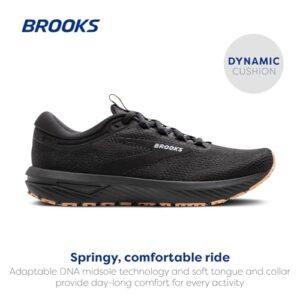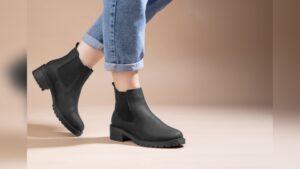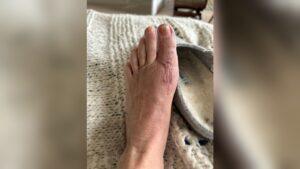Are you wondering if your boots should fit a little loose? It’s a common question that can make a big difference in how comfortable and durable your boots feel.
Too tight, and your feet might ache or blister; too loose, and you could risk blisters or instability. But what’s the right balance? You’ll discover why a slightly loose fit might actually be better in some cases, when to size up or down, and simple tips to find boots that feel just right.
Keep reading to learn how to get the perfect fit that keeps your feet happy, whether you’re exploring Austin’s streets or heading out for an adventure.
Boot Fit Basics
Understanding how boots should fit is key to comfort and foot health. Boots need to feel secure but not tight. Proper fit avoids blisters, pain, and long-term foot issues.
Boots that are too tight can pinch your toes and cause discomfort. Too loose, and your feet may slide inside, causing blisters and instability. Finding the right balance is essential.
Snug Vs Loose Fit
A snug fit means the boot holds your foot firmly without squeezing. It offers support and reduces foot movement inside the boot. A loose fit gives extra room but can cause your foot to slip. Slipping leads to rubbing and blisters. Choose snug over loose for better support and safety.
Toe Space Importance
Toe space lets your toes move slightly and prevents pinching. Your toes should not feel cramped or hit the front of the boot. About a half-inch of space in front of your longest toe is ideal. This space prevents pain during walking or standing long hours.
Heel Fit Considerations
The heel should fit snugly to prevent slipping but not be tight enough to cause pain. Heel lift, or the foot moving up and down inside the boot, can cause blisters. A small amount of heel movement is normal, but excessive lift means the boot is too big. Insoles can help reduce heel slipping if needed.
When To Size Up
Knowing when to size up in boots helps avoid discomfort and improves wear. Boots that fit too tight cause pain and blisters. Boots that are slightly loose can offer more comfort and room. Certain situations call for choosing a larger size. Understanding these can guide you to the best fit for your feet.
Between Sizes
Choosing between two sizes? Pick the larger one. Feet tend to swell during the day. A bigger size allows extra space to prevent tightness. It helps keep your feet comfortable for longer periods. You can always add insoles to fill small gaps.
Thick Socks Usage
Wear thick socks in winter or for hiking? Size up your boots. Thick socks take more space inside the boot. A larger boot stops your feet from feeling cramped. This prevents blisters and foot pain. It also keeps your feet warm and cozy.
Wide Feet Accommodation
Have wide feet that don’t fit well in regular boots? Consider sizing up by half a size. More room in the toe box reduces pressure and discomfort. It helps avoid pinching and sore spots. A little extra space makes walking easier and more enjoyable.
When To Size Down
Knowing when to size down in boots can improve your comfort and fit. Boots that are too loose can cause blisters and discomfort. Sometimes, a smaller size gives a better, snug fit. This works well if the boot material stretches or if you have narrow feet. Understanding these factors helps you choose the right size for your boots.
Stretchable Materials
Some boots are made from materials that stretch over time. Leather is a common stretchable material. It molds to your foot shape with wear. Buying a slightly smaller size can work well here. The boots will feel tight at first but soften later. This snug fit prevents your feet from sliding inside the boots. Keep in mind, leather stretches mostly in width, not length. So avoid sizing down too much in length to prevent pinching your toes.
Narrow Feet Challenges
Narrow feet often struggle to find boots that fit well. Standard boots may feel loose and cause slipping. Sizing down by a half size can help create a tighter fit. This reduces empty space and improves stability. However, sizing down too much may cause discomfort or pain. Narrow boots or brands with narrow options are better choices. If you cannot find these, a smaller size might be the best option. Always try on boots and walk around to check comfort before buying.

Credit: www.bootcountryonline.com
Common Fit Issues
Boots must fit well to keep your feet comfortable and safe. Poor fitting boots cause many problems that affect walking and foot health. Understanding common fit issues helps you choose boots that feel right.
Heel Lift Problems
Heel lift happens when the heel moves up inside the boot. This can cause blisters and discomfort. Too much heel lift means the boot is too loose. A small lift is normal but should not be painful. Adding insoles can reduce heel lift. If the heel lift is large, try a smaller size or boots with better heel support.
Pinching And Rubbing
Pinching happens when boots are too tight in certain areas. This causes pain and may lead to blisters or sores. Common pinch points are the sides and top of the foot. Rubbing occurs when boots constantly rub against the skin. Both issues mean the fit is wrong. Choosing boots with a wider toe box or softer material can help. Never ignore constant rubbing or pinching as it damages skin over time.
Toe Bumping
Toe bumping happens if your toes hit the front of the boot while walking. This causes discomfort and can hurt your toenails. Boots that are too short cause toe bumping. Your toes need some space to move comfortably inside the boot. A thumb’s width of space in front of the longest toe is ideal. Tight boots that cause toe bumping will make walking painful and damage your feet.
Tips For Trying Boots
Trying on boots can be tricky without the right approach. Follow simple tips to find boots that fit well and feel comfortable. These tips help avoid common mistakes and ensure your boots suit your feet perfectly.
Small changes in how you try boots can make a big difference in fit and comfort. Keep these tips in mind next time you shop for boots.
Wear Correct Socks
Always wear the socks you plan to use with the boots. Thick winter socks take up more space inside the boots. Thin dress socks need less room. Wearing the right socks gives a true idea of the boot’s fit. This avoids buying boots that feel tight or loose later.
Try Boots In Afternoon
Feet swell during the day, especially after walking or standing. Try boots in the afternoon when your feet are at their largest. Boots that fit well later in the day will feel comfortable all day long. Buying boots in the morning can lead to tight, painful fits by evening.
Walk Around Test
Take a good walk in the boots before buying. Walk on different surfaces to check support and comfort. Pay attention to tight spots or heel slipping. Boots should feel snug but not pinch or rub. Walking helps spot problems that sitting or standing might hide.
Adjusting Fit After Purchase
Adjusting the fit of boots after purchase can make a big difference in comfort. Boots that feel slightly loose can be improved with simple methods. These adjustments help avoid discomfort and improve walking stability.
Here are some easy ways to adjust your boots for a better fit.
Using Insoles
Insoles add extra cushioning and fill up space inside the boot. They help reduce slipping and provide more support. Choose insoles that match your foot shape for the best results. This is a quick and affordable way to make boots fit better.
Thicker Socks
Wearing thicker socks can fill extra space inside your boots. This reduces looseness and adds warmth. Thick socks are perfect for cold weather and improve comfort. Try different sock thicknesses to find what feels right for you.
Professional Stretching
Professional stretching can adjust boots that feel too tight or stiff. Specialists use tools to gently widen or lengthen boots. This service is good for leather boots and prevents damage. It helps boots fit better without causing pain.
Boot Materials And Fit
Choosing the right boot fit depends greatly on the material used. Different materials react differently to foot shape and movement. Understanding these differences helps you decide if boots should feel a little loose or snug at first. Fit also affects comfort and how long boots last.
Leather Stretching
Leather is a natural material that softens and molds to your foot over time. It stretches mostly in width, not length. A snug fit is okay because leather will give a little with wear. Boots made of leather often need a break-in period to reach perfect comfort.
Synthetic Materials
Synthetic materials do not stretch as much as leather. They keep their shape longer but can feel tight if sized too small. These boots should fit comfortably from the start. A little looseness might cause slipping or blisters. Choose a size that fits well right away.
Breaking In Period
All boots, especially leather ones, require some breaking in. This means wearing them for short periods until they soften. Boots may feel tight at first but will become more comfortable. Avoid boots that pinch or cause pain. A proper break-in makes boots feel like they were made for your feet.

Credit: www.reddit.com
Special Considerations
Special considerations play a big role in deciding if boots should fit a little loose. Different types of boots and conditions affect how snug or loose they need to be. Understanding these factors helps you choose boots that feel comfortable and work well for your needs.
Hiking And Work Boots
Hiking and work boots often need a bit of extra room. Feet tend to swell after long hours of activity. A slightly loose fit prevents blisters and pressure points. But boots should not be too loose to avoid slipping and losing support. Proper fit helps keep feet stable on rough terrain or during heavy labor.
Fashion Vs Function
Fashion boots usually fit more snugly to look sleek. A tight fit shows off the boot’s shape better. Function boots focus on comfort and protection. They allow some room for movement and thicker socks. Prioritize the purpose of the boots to decide on a looser or tighter fit. Comfort matters more for daily wear than style.
Seasonal Fit Changes
Feet change size with the seasons. Hot weather causes feet to swell. Cold weather makes feet smaller and you may wear thick socks. Boots that are perfect in summer may feel tight in winter. Choosing a slightly loose fit gives room for these changes. It keeps boots comfortable year-round without pinching or pressure.

Credit: www.reddit.com
Frequently Asked Questions
Is It Better To Size Up Or Down In Boots?
Size up if between sizes, wear thick socks, or have wide feet for comfort and room. Size down only if leather stretches and you want a snug fit. Always prioritize a comfortable, snug fit without toe pinching or heel lifting.
How Much Wiggle Room Should Boots Have?
Boots should have about a thumb’s width (half an inch) of wiggle room at the toe for comfort. This prevents pinching and allows foot swelling during wear. Ensure a snug fit around the heel to avoid slipping while maintaining enough space to move toes naturally.
How To Tell If A Boot Fits Correctly?
A boot fits correctly when your heel stays secure without slipping. Your toes should have slight wiggle room and not touch the front. The boot feels snug but not tight, with no pinching or discomfort. Walk to ensure no rubbing or pressure points occur.
Are Boots Supposed To Slip A Little?
Boots may slip slightly at first but should fit snugly without excessive heel lift. A little slip is normal to avoid tightness and allow comfort. If slipping feels large or causes discomfort, try insoles or a smaller size for better fit and stability.
Conclusion
Choosing the right boot fit matters for comfort and foot health. Boots should feel snug but not tight. A little looseness can help if you wear thick socks or have wider feet. Avoid boots that pinch or cause pain. Always try boots on and walk around before buying.
Remember, comfort lasts longer than style. Your feet will thank you for the right fit every step of the way.

Madison Clark is a footwear expert and the voice behind MyStyleGrid.com. She specializes in honest shoe reviews, style tips, and practical guides to help readers find the perfect pair for any occasion. With years of experience in blogging and content creation, Madison makes footwear knowledge simple, stylish, and easy to follow.






